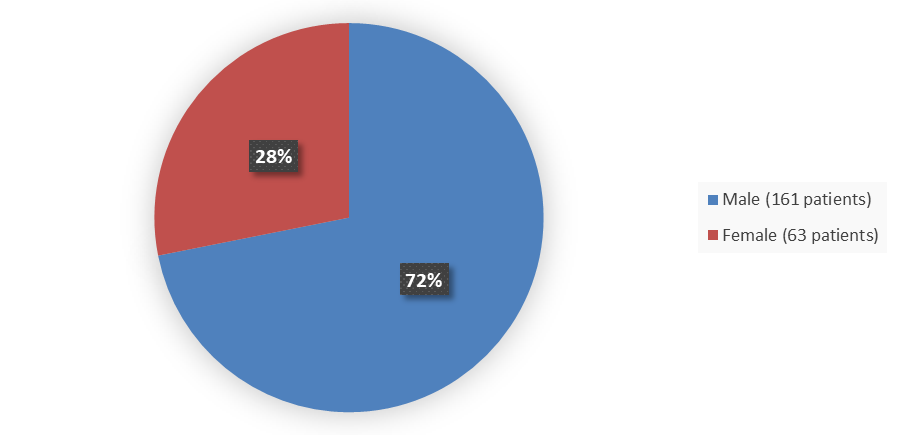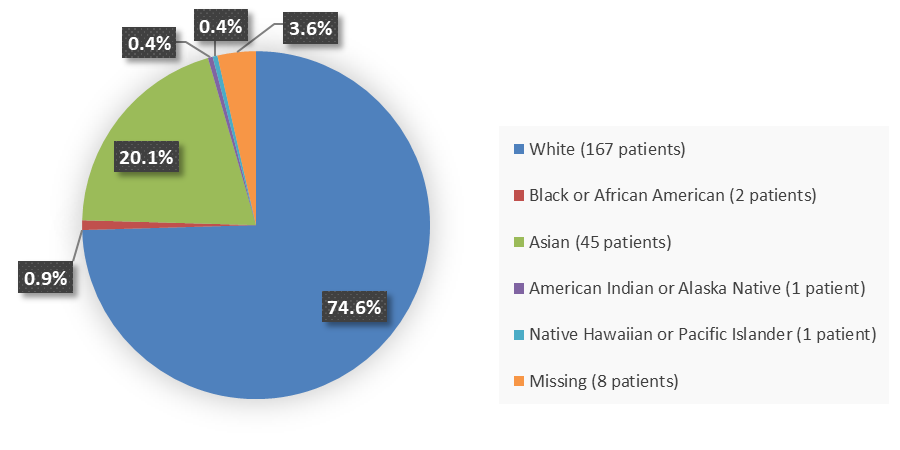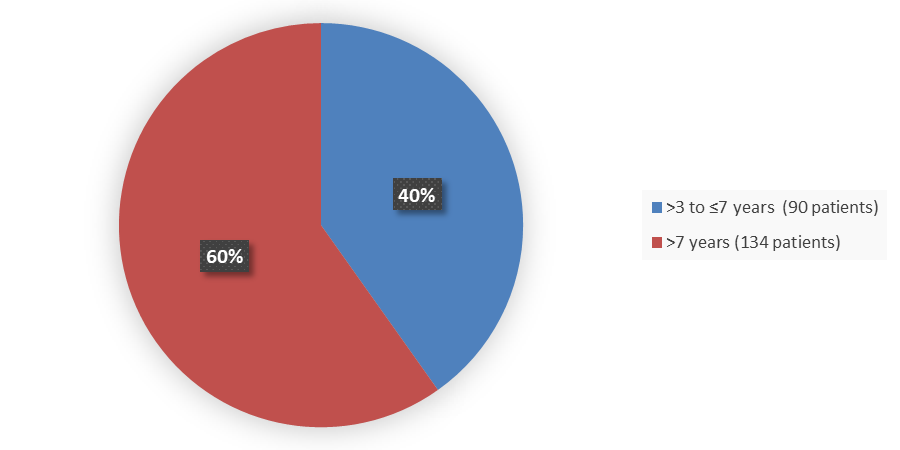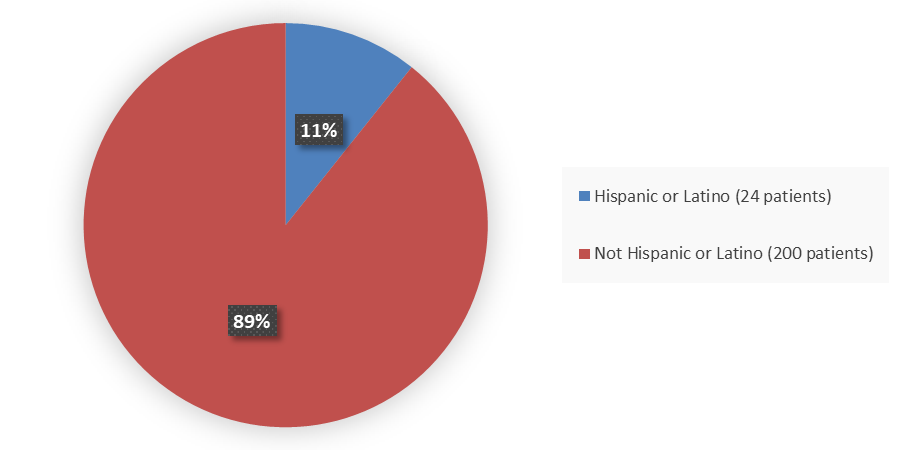Drug Trials Snapshots: NGENLA
HOW TO USE THIS SNAPSHOT
The information provided in Snapshots highlights who participated in the key clinical trials that supported the original FDA approval of this drug, and whether there were differences among sex, race, age, and ethnic groups. The “MORE INFO” bar shows more detailed, technical content for each section. The Snapshot is intended as one tool for consumers to use when discussing the risks and benefits of the drugs.
LIMITATIONS OF THIS SNAPSHOT:
Do not rely on Snapshots to make decisions regarding medical care. Always speak to your healthcare provider about the benefits and risks of a drug.
Some of the information in this Snapshot is for presentation purposes and does not represent the approved conditions of use of this drug. Refer to the NGENLA Prescribing Information for all of the approved conditions of use of this drug (e.g., indication(s), population(s), dosing regimen(s), safety information).
Snapshots are limited to the information available at the time of the original approval of the drug and do not provide information on who participated in clinical trials that supported later approvals for additional uses of the drug (if applicable).
NGENLA (somatrogon-ghla)
en’ JEN-lah
Pfizer
Original Approval date: June 27, 2023
DRUG TRIALS SNAPSHOT SUMMARY:
What is the drug for?
NGENLA is a human growth hormone for the treatment of children 3 years of age and older who are not growing because they have growth hormone deficiency (GHD).
GHD is a condition in which the body does not produce enough growth hormone (GH). Symptoms of GHD in children include poor growth and short stature.
How is this drug used?
NGENLA is given as an injection under the skin (subcutaneous) once weekly.
Who participated in the clinical trials?
The FDA approved NGENLA based on one clinical trial (NCT 02968004) of 224 pediatric patients with growth hormone deficiency and short stature. The trial was conducted at 84 sites in 24 countries including Argentina, Australia, Bulgaria, Belarus, Canada, Colombia, Germany, Georgia, Greece, India, Israel, Italy, Mexico, New Zealand, Poland, South Korea, Russia, Spain, Taiwan, Turkey, Ukraine, the United Kingdom, Vietnam, and the United States of America. This trial was used to assess efficacy and safety.
How were the trials designed?
The benefits and side effects of NGENLA were evaluated in a clinical trial. Pediatric patients 3 to 12 years old were assigned at random to weekly NGENLA or another daily approved growth hormone for 52 weeks.
The benefit of NGENLA was assessed by measuring the annualized height velocity (change in standing height over one year) and comparing it to the once daily human growth hormone group.
How were the trials designed?
There was one multinational, controlled trial that provided data to support the approval of NGENLA. Patients 3 to 12 years old with short stature due to GHD were randomized to once-weekly NGENLA or to another approved once daily growth hormone for a total of 52 weeks.
The height gain at Week 52 was measured in each group and compared.
DEMOGRAPHICS SNAPSHOT
Figure 1 summarizes how many male and female children were enrolled in the clinical trial.
Figure 1. Baseline Demographics by Sex
Source: Adapted from FDA Review
Figure 2 summarizes the percentage of patients by race enrolled in the clinical trial.
Figure 2. Baseline Demographics by Race
Source: Adapted from FDA Review
Figure 3 summarizes the percentage of patients by age enrolled in the clinical trial.
Figure 3. Baseline Demographics by Age
Source: Adapted from FDA Review
Figure 4 summarizes the percentage of patients by ethnicity enrolled in the clinical trial.
Figure 4. Baseline Demographics by Ethnicity
Source: Adapted from FDA Review
Who participated in the trials?
Table 1 summarizes the percentage of patients by sex.
Table 1. Baseline Demographics
|
|
Total Patients |
|---|---|
|
Sex |
|
|
Male |
161 (72) |
|
Female |
63 (28) |
|
Race |
|
|
White |
167 (75) |
|
Black of African American |
2 (1) |
|
Asian |
45 (20) |
|
American Indian or Alaska Native |
1 (<1) |
|
Native Hawaiian or Pacific Islander |
1 (<1) |
|
Missing |
8 (4) |
|
Age group, years |
|
|
>3 to ≤7 |
90 (40) |
|
>7 |
134 (60) |
|
Ethnicity |
|
|
Hispanic or Latino |
24 (11) |
|
Not Hispanic or Latino |
200 (89) |
Source: Adapted from FDA Review
What are the benefits of this drug?
In a clinical trial, children who were treated with NGENLA once weekly had growth that was similar to children treated with an approved human growth hormone injection given once daily.
What are the benefits of this drug (results of trials used to assess efficacy)?
Efficacy results from the trial are presented in Table 2. The primary endpoint was the annualized height velocity, which is the change in standing height over a period of one year. The secondary endpoint was the change in standard deviation scores of height from baseline (a number used to tell how different a child’s height is from the average expected height of a child of similar age and sex).
Table 2. Growth Parameters at Week 52 in Pediatric Treatment-Naïve Subjects With Growth Hormone Deficiency
|
|
NGENLA |
Daily Somatropin |
|---|---|---|
|
Annualized height velocity (cm/year) |
10.1 |
9.8 |
|
Height SDS |
-1.94 |
-1.99 |
|
Height SDS, change from baseline |
0.92 |
0.87 |
Source: Adapted from FDA Review
Abbreviations: N, number of subjects; SDS, standard deviation score
Were there any differences in how well the drug worked in clinical trials among sex, race and age?
- Sex: NGENLA worked similarly in male and female children.
- Race: NGENLA worked similarly in Asians and Whites. The number of patients of other races was small; therefore, differences in how NGENLA worked among other races could not be determined.
- Age: NGENLA worked similarly in all ages of children that were studied.
Were there any differences in how well the drug worked in clinical trials among sex, race, and age groups?
The subgroup analyses of the primary endpoint are presented in Table 3.
Table 3. Annualized Height Velocity at Week 52 by Sex, Age, and Race
|
|
Annualized Height Velocity |
Difference1 (95% CI) |
|
|---|---|---|---|
|
NGENLA |
Somatropin |
||
|
Sex |
|||
|
Male |
10 |
9.8 |
0.27 (-0.38, 0.89) |
|
Female |
10.3 |
9.6 |
0.46 (-0.40, 1.37) |
|
Age group, years |
|||
|
>3 to ≤7 |
10.4 |
10.3 |
0.24 (-0.54, 0.98) |
|
>7 |
9.9 |
9.4 |
0.39 (-0.25, 1.03) |
|
Race |
|||
|
Asian |
10.6 |
9.2 |
0.75 (-0.39, 2.22) |
|
White |
10.1 |
9.9 |
0.21 (-0.41, 0.83) |
Source: Adapted from FDA Review
1 Treatment differences and credible intervals may not match values of (treatment minus control) since estimates include relevance of outcomes from other subgroups.
Abbreviations: CI, credible interval
What are the possible side effects?
NGENLA may cause serious side effects including:
- Allergic reactions
- Increased risk of cancer that is already present or new cancer
- New or worsening high blood sugar
- Increased intracranial pressure (pressure in the skull)
- Body fluid retention
- Decreased adrenal and thyroid gland function
- Slipped capital femoral epiphysis (“ball part” of the top of the thigh bone slips at the growth plate)
- Worsening of scoliosis (sideways curvature of the spine) that is already present
- Inflammation of pancreas
- Loss of fat tissue at the injection site
The most common side effects include injection site reactions, upper respiratory tract infections, headache, pyrexia, anemia, hypothyroidism, rash, and increased blood eosinophil levels.
What are the possible side effects (results of trials used to assess safety)?
Table 4 shows the frequency of side effects occurring in ≥5% of patients treated with NGENLA.
Table 4. Side Effects Occurring in ≥5% NGENLA-Treated Pediatric Patients (52 Weeks of Treatment)
|
|
NGENLA |
Daily Somatropin |
|---|---|---|
|
Injection site reactions1 |
46 (42) |
29 (25) |
|
Nasopharyngitis2 |
36 (33) |
33 (29) |
|
Headache |
18 (16) |
25 (22) |
|
Pyrexia |
18 (16) |
17 (15) |
|
Anemia |
10 (9) |
10 (9) |
|
Cough |
9 (8) |
9 (8) |
|
Vomiting |
8 (7) |
9 (8) |
|
Hypothyroidism |
7 (6) |
3 (3) |
|
Abdominal pain |
7 (6) |
8 (7) |
|
Rash |
6 (5) |
7 (6) |
|
Oropharyngeal pain |
6 (5) |
4(3) |
Source: NGENLA Prescribing Information
1 Injection site reactions included: injection site pain (39% NGENLA versus 25% daily somatropin); injection site swelling, induration, hypertrophy, or inflammation (10% NGENLA versus 1% daily somatropin); injection site erythema (8% NGENLA versus zero daily somatropin); injection site pruritus (5% NGENLA versus zero daily somatropin); and injection site hemorrhage (5% NGENLA versus zero daily somatropin).
2 Nasopharyngitis included: rhinitis, pharyngitis, rhinitis allergic, pharyngitis streptococcal, viral pharyngitis, nasopharyngitis. Abbreviations: N, total number of patients in the group; n, number of patients with the side effect
Were there any differences in side effects of the clinical trials among sex, race, and age?
- Sex: The occurrence of side effects was similar in male and female children.
- Race: The occurrence of side effects was similar in White and Asian patients. The number of patients of races other than White and Asian was small; therefore, differences in side effects among races other than White and Asian could not be determined.
- Age: The occurrence of side effects was similar in patients below and above 7 years of age.
Were there any differences in side effects of the clinical trials among sex, race, and age groups?
Table 5. Overview of Side Effects by Sex, Race, and Age in Pediatric Patients With Growth Hormone Deficiency
|
Demographic |
NGENLA |
Daily Somatropin |
||
|---|---|---|---|---|
|
All Grades |
Grade ≥3 |
All Grades |
Grade ≥3 |
|
|
Sex |
||||
|
Female |
25/27 (92.6) |
3/27 (11.1) |
30/36 (83.3) |
2/36 (5.6) |
|
Male |
70/82 (85.4) |
5/82 (6.1) |
67/79 (84.8) |
4/79 (5.1) |
|
Race |
||||
|
Asian |
20/24 (83.3) |
1/24 (4.2) |
16/21 (76.2) |
1/21 (4.8) |
|
Black or African American |
0/0 (NA) |
0/0 (NA) |
2/2 (100) |
0/2 (0) |
|
White |
71/81 (87.7) |
6/81 (7.4) |
75/86 (87.2) |
5/86 (5.8) |
|
All others |
1/1 (100) |
1/1 (100) |
1/1 (100) |
0/1 (0) |
|
Age group, years |
||||
|
≤7 |
41/43 (95.3) |
3/43 (7.0) |
42/47 (89.4) |
4/47 (8.5) |
|
>7 |
54/66 (81.8) |
5/66 (7.6) |
55/68 (80.9) |
2/68 (2.9) |
Source: Adapted from FDA Review
Abbreviation: N, number of patients in the safety population; n, number of patients with given characteristic; NA, not applicable; Ns, total number of patients for each specific subgroup and were assigned to that specific arm
GLOSSARY
CLINICAL TRIAL: Voluntary research studies conducted in people and designed to answer specific questions about the safety or effectiveness of drugs, vaccines, other therapies, or new ways of using existing treatments.
COMPARATOR: A previously available treatment or placebo that is compared to the actual drug being tested.
EFFICACY: How well the drug achieves the desired response when it is taken as described in a controlled clinical setting, such as during a clinical trial.
PLACEBO: An inactive substance or “sugar pill” that looks the same as, and is given the same way as, an active drug or treatment being tested. The effects of the active drug or treatment are compared to the effects of the placebo.
SUBGROUP: A subset of the population studied in a clinical trial. Demographic subsets include sex, race, and age groups.




